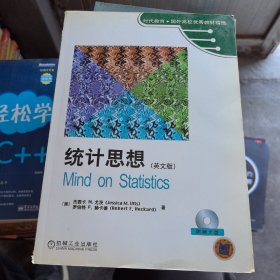
统计思想(带光盘)
无笔记划线
¥ 19.8 3.0折 ¥ 66 九品
仅1件
作者[美]尤茨(Utts J.M) 著
出版社机械工业出版社
出版时间2005-01
版次1
装帧平装
货号h14
上书时间2024-03-21
- 在售商品 暂无
- 平均发货时间 10小时
- 好评率 暂无
- 店主推荐
- 最新上架
商品详情
- 品相描述:九品
图书标准信息
- 作者 [美]尤茨(Utts J.M) 著
- 出版社 机械工业出版社
- 出版时间 2005-01
- 版次 1
- ISBN 9787111109464
- 定价 66.00元
- 装帧 平装
- 开本 其他
- 纸张 胶版纸
- 页数 646页
- 字数 1050千字
- 【内容简介】
-
《统计思想(英文版)(原书第2版)(附1CD)》保持了第1版的特点:作为统计学的入门教材,对数学基础知识的要求较低;用丰富、新鲜的例子说明统计学的概念、原理和运算程序,使全书极具趣味性和引人入胜;同时计算机、互联网以及多媒体教学手段的合理充分的使用,改变了统计学课程教学中原有的面貌,使学习和掌握统计学变得生动、活泼和十分容易。
全书内容包括数据的采集、整理与概括,变量之间的相关关系与分析,概率与随机变量,随机变量的数字特征,点估计和区间估计,回归分析与方差分析等内容。本书的特点是以讲统计学为主,概率论的内容服从和服务于统计学,占很小部分,而且两者穿插结合得如此恰当、完美,令人佩服。本书前四章讲抽样调查,把问题讲得很清楚、很好懂,是国内教材中不多见的。本书有两章讲分类变量之间的关系与分析,也是国内教材中不安排或很少安排的,而实际上这部分内容是很有用的。
全书自成体系,对统计学的原则和概念叙述得相当清楚和准确。书中的框图、小结等也使本书增色不少。
本书第2版比第1版在各章节中适当增加了一些内容和例子。各章节的习题有所增加,某些章节中增加了“打开计算机”的环节,为读者提供通过计算机掌握统计概念的手段。书末的光盘提供的内容要比第1版的光盘内容丰富许多。对全书的主要内容已作出PowerPoint,可直接用于双语教学。同时光盘中有数据和用各种统计软件解决实例的程序。 - 【目录】
-
出版说明.
序
chapter 1 statistics success stories and cautionary tales
1.1 what is statistics?
1.2 seven statistical stories with morals
1.3 the common elements in the seven stories
key terms
exercises
referenceschapter 2 turning data into information
2.1 raw data
2.2 types of data
2.3 summarizing one or two categorical variables
2.4 finding information in quantitative data
2.5 pictures for quantitative data
2.6 numerical summaries of quantitative variables
2.7 bell-shaped distributions of numbers
key terms
exercises
referenceschapter 3 gathering useful data
3.1 description or decision? using data wisely
3.2 speaking the language of research studies
3.3 designing a good experiment
3.4 designing a good observationalstudy
3.5 difficulties and disasters in experiments and
observational studies
key terms
exercises
referenceschapter 4 sampling: surveys and how to ask questions
4.1 the beauty of sampling
4.2 simple random sampling and randomization
4.3 other sampling methods
4.4 difficulties and disasters in sampling
4.5 how to ask survey questions
key terms
exercises
referenceschapter 5 relationships between ouantitative variables
5.1 looking for patterns with scatterplots
5.2 describing linear patterns with a regression line
5.3 measuring strength and direction with correlation
5.4 why the answers may not make sense
5.5 correlation does not prove causation
6.1 displaying relationships between categcal variables
6.2 risk, relative risk, odds ratio, and increased risk
6.3 misleading statistics about risk
6.4 the effect of a third variable and simpson's paradox
6.5 assessing the statistical significance of a 2×2 table
key terms
exercises
referenceschapter 7 probability
7.1 random circumstances
7.2 interpretations of probability
7.3 probability definitions and relationships
7.4 basic rules for finding probabilities
7.5 strategies for finding complicated probilities
7.6 using simulation to estimate probabilities
7.7 coincidences and intuitive judgments about probability
key terms
exercises
references
……chapter 8 random variables
8.1 what is a random variable?
8.2 discrete random variables
8.3 expectations for random variables
8.4 binomial random variables
8.5 continuous random variables
8.6 normal random variables
8.7 approximating binomial distribution probabilities
8.8 sums, differences, and combinations of random variables
key terms
exerciseschapter 9 means and proportions as random variables
9.1 understanding dissimilarity among samples
9.2 sampling distributions for sample proportions
9.3 what to expect of sample means
9.4 what to expect in other situations: central limit theorem 309
9.5 sampling distribution for any statistic
9.6 standardized statistics
9.7 student's t-distribution: replacing σwith s
9.8 statistical inference
key terms
exercises
referenceschapter 10 estimating proportions with confidence..
10.1 the language and notation of estimation
10.2 margin of error
10.3 confidence intervals
10.4 calculating a margin of error for 95% confidence
10.5 general theory of confidence intervals for a proportion
10.6 choosing a sample size for a survey
10.7 using confidence intervals to guide decisions
key terms
exercises
referenceschapter 11 testing hypotheses about proportions
11.1 formulating hypothesis statements
11.2 the logic of hypothesis testing: what if the null is true?
11.3 reaching a conclusion about the two hypotheses
11.4 testing hypotheses about a proportion
11.5 the role of sample size in statistical significance
11.6 real importance versus statistical significance
11.1 what can go wrong: the two types of errors
key terms
exercises
referenceschapter 12 more about confidence intervals
12.1 examples of different estimation situations
12.2 standard errors
12.3 approximate 95% confidence intervals
12.4 general confidence intervals for one mean or paired data
12.5 general confidence intervals for the difference betw two means (independent samples)
12.6 the difference between two proportions (independent samples)
12.7 understanding any confidence interval
key terms
exercises
referenceschapter 13 more about significance tests
13.1 the general ideas of significance testing
13.2 testing hypotheses about one mean or paired data
13.3 testing the difference between two means (independent samples)
13.4 testing the difference between two population proportions
13.5 the relationship between significance tests and confidence intervals
13,6 choosing an'appropriate inference procedure
13.7 the two types of errors and their probabilities
13.8 effect size
13.9 evaluating significance in research reports
summary of procedures for hypothesis tests
key terms
exercises
referenceschapter 14 more about regression
14.1 sample and population regression models
14.2 estimating the standard deviation for regression
14.3 inference about the linear regression relationship
14.4 predicting the value of y for an individual
14.5 estimating the mean y at a specified x
14.6 checking conditions for using regression models for inference
key terms
exercises
referenceschapter 15 more about categorical variables
15.1 the chi-square test for two-way tables
15.2 analyzing 2 ~ 2 tables
15.3 testing hypotheses about one categorical variable: goodness of fit
key terms
exercises
referenceschapter 16 analysis of variance
16.1 comparing means with an anova f-test
16.2 details of one-way analysis of variance
16.3 other methods'for comparing populations
16.4 two-way analysis of variance
key terms
exercises
referenceschapter 17 turning information into wisdom
17.1 beyond the data
17.2 transforming uncertainty into wisdom
17.3 making personal decisions
17.4 control of societal risks
17.5 understanding our world
17.6 getting to know you
17.1 words to the wise
exercises
references
appendix of tables
answers to selected exercises
index
supplemental topic 1 additional discrete random variables
supplemental topic 2 nonpammetric tests of hypotheses
supplemental topic 3 multiple regression
supplemental topic 4 two-way analysis of variance
supplemental topic 5 ethics...
— 没有更多了 —






























以下为对购买帮助不大的评价